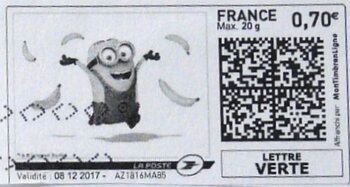Stamp: Minion with Bananas in black (France 2017)
Minion with Bananas in black (France 2017)
01 January (France ) within release MonTimbrEnLigne. Despicable Movies goes into circulation Stamp Minion with Bananas in black face value 0.70 Euro
| Stamp Minion with Bananas in black in catalogues | |
|---|---|
| Colnect codes: | Col: FR-TIM 2017-155b |
Stamp is square format.
Also in the issue MonTimbrEnLigne. Despicable Movies:
- Stamp - Minion Banana! face value Lettre;
- Stamp - Minion in straw hat face value Lettre;
- Stamp - Minions holding Hands face value Prioritaire;
- Stamp - Minion with Bananas face value 0.83;
- Stamp - Minion with Bananas in black face value 0.70;
- Stamp - Minions holding Hands in black face value 1.16;
- Stamp - Minions with giant banana face value 1.05;
- Stamp - Minion with Bananas face value 0.70;
|
Data entry completed
46%
|
|
|---|---|
| Stamp Minion with Bananas in black in digits | |
| Country: | France |
| Date: | 2017-01-01 |
| Emission: | Personalized - Official |
| Format: | Stamp |
| Face Value: | 0.70 Euro |
Stamp Minion with Bananas in black it reflects the thematic directions:
A cartoon is a type of visual art that is typically drawn, frequently animated, in an unrealistic or semi-realistic style. The specific meaning has evolved, but the modern usage usually refers to either: an image or series of images intended for satire, caricature, or humor; or a motion picture that relies on a sequence of illustrations for its animation. Someone who creates cartoons in the first sense is called a cartoonist, and in the second sense they are usually called an animator.
The concept originated in the Middle Ages, and first described a preparatory drawing for a piece of art, such as a painting, fresco, tapestry, or stained glass window. In the 19th century, beginning in Punch magazine in 1843, cartoon came to refer – ironically at first – to humorous artworks in magazines and newspapers. Then it also was used for political cartoons and comic strips. When the medium developed, in the early 20th century, it began to refer to animated films that resembled print cartoons.
In botany, a berry is a fleshy fruit without a drupe (pit) produced from a single flower containing one ovary. Berries so defined include grapes, currants, and tomatoes, as well as cucumbers, eggplants (aubergines), persimmons and bananas, but exclude certain fruits that meet the culinary definition of berries, such as strawberries and raspberries. The berry is the most common type of fleshy fruit in which the entire outer layer of the ovary wall ripens into a potentially edible "pericarp". Berries may be formed from one or more carpels from the same flower (i.e. from a simple or a compound ovary).: 291 The seeds are usually embedded in the fleshy interior of the ovary, but there are some non-fleshy exceptions, such as Capsicum species, with air rather than pulp around their seeds.


